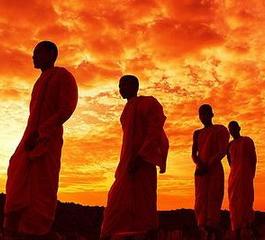 The patronage of the Emperor Ashoka helped to establish Buddhism as one of the major religions of Asia. However, the Emperor’s largess also enticed opportunists and poseurs. A third Buddhist Council was convened about 244 BCE to clarify Buddhist doctrine and stop the spread of heresies.
The patronage of the Emperor Ashoka helped to establish Buddhism as one of the major religions of Asia. However, the Emperor’s largess also enticed opportunists and poseurs. A third Buddhist Council was convened about 244 BCE to clarify Buddhist doctrine and stop the spread of heresies.
The body of doctrine agreed upon by the council came to be called Vibhajjavada, the “doctrine of analysis,” because of an emphasis on critical analysis and reason rather than blind faith. Vibhajjavada was not intended to be a departure from the older school of Buddhism, but rather considered itself to represent original Buddhist orthodoxy.
The monk Mahinda, thought to be a son of Ashoka, took Vibhajjavada Buddhism into Sri Lanka ca. 246 BCE, where it was propagated by monks of the Mahavihara monastery. This branch of Vibhajjavada came to be called Tamraparniya, “the Sri Lankan lineage.” Other branches of Vibhajjavada Buddhism died out, but Tamraparniya survived and came to be called Theravada, “teachings of the elders of the order.”
Today Theravada is widespread throughout Southeast Asia and is the oldest surviving school of Buddhism.
By Barbara O’brien
Source : buddhism.about.com





Comments are closed.